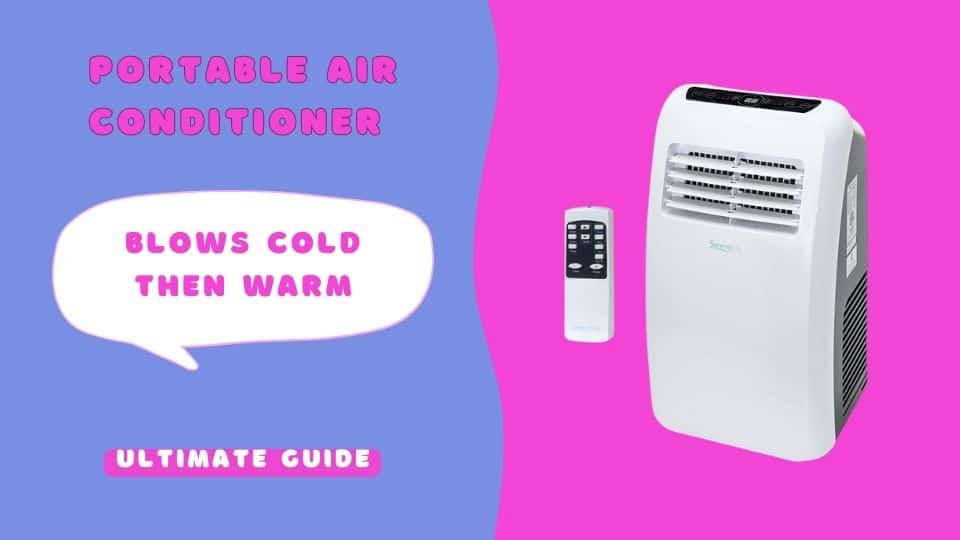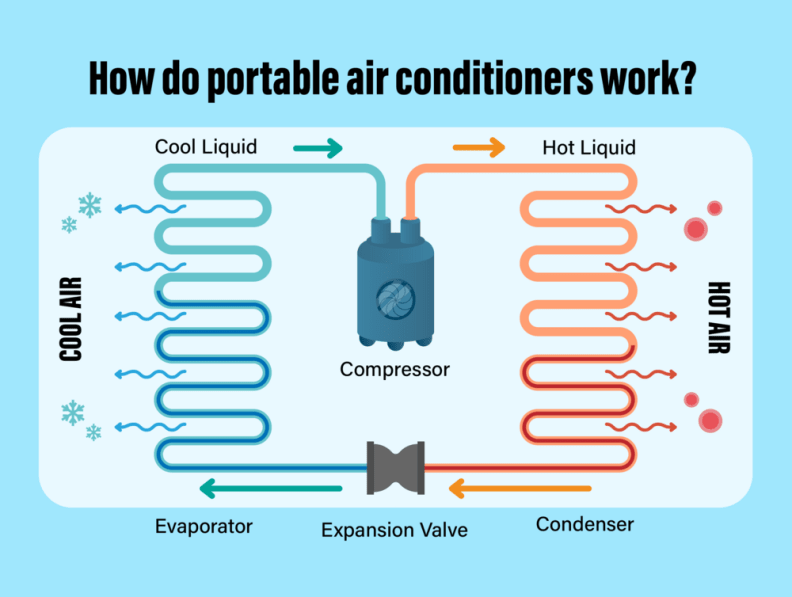Portable Air Conditioner Blowing Hot Air

Portable Air Conditioner Blowing Hot Air? Troubleshooting and Solutions for Energy Savings
Portable air conditioners (PACs) offer a flexible and often affordable cooling solution, especially for smaller spaces or as supplemental cooling. However, nothing is more frustrating than a portable AC unit blowing hot air, especially when you're trying to beat the heat and save on energy costs. This article delves into the common causes of this issue, provides troubleshooting steps, and explores strategies to improve your PAC's performance, ultimately leading to greater energy efficiency and lower bills.
Understanding Why Your Portable AC is Blowing Hot Air
Several factors can contribute to a portable AC blowing hot air. Identifying the root cause is crucial for implementing the correct solution. Here are the most common culprits:
- Insufficient Exhaust: This is often the primary reason. Portable ACs work by extracting heat from the room and venting it outside. If the exhaust hose isn't properly sealed or is kinked, the hot air gets reintroduced into the room, negating the cooling effect.
- Dirty Air Filter: A clogged air filter restricts airflow, forcing the unit to work harder and reducing its cooling capacity. Over time, this leads to diminished performance and potentially overheating, resulting in warm air being discharged.
- Refrigerant Leaks: While less common in portable ACs compared to central AC systems, refrigerant leaks can still occur. Low refrigerant levels reduce the unit's ability to cool effectively. This is a more serious issue requiring professional attention.
- Overheating: Excessive use or poor ventilation can cause the unit to overheat, triggering safety mechanisms that reduce or halt cooling. This is often accompanied by the unit shutting off intermittently.
- Incorrect Size: If the portable AC unit is too small for the room it's trying to cool, it will struggle to lower the temperature effectively, and you might perceive it as blowing hot air.
- Damaged Components: Like any appliance, portable ACs can experience component failures. A faulty compressor, fan motor, or thermostat can all lead to reduced cooling performance.
Troubleshooting Steps: A DIY Approach
Before calling a technician, try these troubleshooting steps to diagnose and potentially resolve the issue yourself:
- Check the Exhaust Hose: Ensure the exhaust hose is securely connected to both the unit and the window adapter. Look for kinks, bends, or obstructions that might be restricting airflow. Ideally, the hose should be as straight and short as possible. A poorly installed or damaged hose is the equivalent of leaving a window open on a hot day – all that cool air is wasted. Seal any gaps around the window adapter with foam or weather stripping to prevent hot air from seeping back into the room. Consider using a professional window kit for a tighter seal and increased efficiency.
- Clean or Replace the Air Filter: Locate the air filter (usually on the back or side of the unit) and remove it. Clean it thoroughly with a vacuum cleaner or mild soap and water. Allow it to dry completely before reinstalling. If the filter is damaged or excessively dirty, replace it with a new one. Regular filter cleaning (every 2-4 weeks, depending on usage) is crucial for maintaining optimal performance and preventing strain on the unit. A clean filter translates directly into lower energy consumption.
- Ensure Proper Ventilation: Make sure the area around the portable AC unit is well-ventilated. Don't block the intake or exhaust vents with furniture or curtains. Allow ample space for air to circulate freely.
- Empty the Water Tank: Some portable AC models have a water tank that needs to be emptied periodically. A full tank can sometimes affect cooling performance. Check the manufacturer's instructions for specific details on emptying the tank.
- Check for Ice Buildup: In humid conditions, ice can form on the evaporator coils, hindering cooling. If you suspect ice buildup, turn off the unit and let it thaw completely before restarting it. Ensure adequate airflow to prevent future ice formation.
- Room Size Appropriateness: Double-check that the unit's BTU (British Thermal Units) rating is appropriate for the size of the room. The higher the BTU rating, the larger the area the unit can effectively cool. Using a unit with insufficient BTU for the space will result in poor cooling performance and increased energy consumption. Consult Energy Star guidelines for recommended BTU levels based on room size.
When to Call a Professional HVAC Technician
If you've tried the above troubleshooting steps and your portable AC is still blowing hot air, it's time to call a qualified HVAC technician. Issues such as refrigerant leaks, compressor problems, or faulty electrical components require professional diagnosis and repair. Attempting to fix these issues yourself can be dangerous and may void the warranty.
Maximizing Energy Efficiency: Tips and Best Practices
Even with a properly functioning portable AC, you can still take steps to maximize energy efficiency and minimize your energy bills:
- Use a Programmable Timer: Set the timer to turn the unit on and off according to your schedule. Cool the room before you arrive home or before you go to bed, rather than running the unit continuously. Many newer models come with built-in programmable timers.
- Seal the Room: Close windows and doors to prevent hot air from entering the room. Use weather stripping or caulk to seal any gaps or cracks around windows and doors. This will help the unit maintain a consistent temperature and reduce energy consumption.
- Use Ceiling Fans: Ceiling fans help circulate the cool air produced by the portable AC, allowing you to set the thermostat higher and save energy.
- Position Strategically: Place the portable AC unit in a location where it can effectively circulate air throughout the room. Avoid placing it near heat sources or in direct sunlight.
- Energy Star Certification: When purchasing a new portable AC, look for the Energy Star label. Energy Star certified models are more energy-efficient than standard models and can save you money on your energy bills over time. Check the Energy Star website for current ratings and comparisons.
- Consider a Smart Portable AC: Some portable AC models come with smart features, such as Wi-Fi connectivity and smartphone app control. These features allow you to remotely monitor and adjust the temperature, set schedules, and track energy usage, further optimizing energy efficiency. Integration with smart home ecosystems like Amazon Alexa or Google Assistant allows for voice control and automated operation.
- Regular Maintenance: Follow the manufacturer's instructions for regular maintenance, including cleaning the air filter and inspecting the exhaust hose. Proper maintenance will help ensure the unit operates efficiently and prolong its lifespan.
The ROI of Energy-Efficient Cooling
Investing in energy-efficient cooling solutions, including properly maintaining your portable AC, can yield significant returns in the long run. Lower energy bills, reduced environmental impact, and increased comfort are just some of the benefits. Furthermore, many utility companies offer rebates and incentives for purchasing Energy Star certified appliances, further reducing the upfront cost and accelerating the return on investment. Check with your local utility company for available programs.
Smart Home Integration for Enhanced Control
The integration of smart home technology with HVAC systems is transforming the way we manage our indoor climate. Smart thermostats and sensors can automatically adjust the temperature based on occupancy, weather conditions, and personal preferences. This level of automation can significantly reduce energy waste and optimize comfort. While portable AC units may not always integrate as seamlessly as central systems, some models offer Wi-Fi connectivity and app control, allowing for remote monitoring and scheduling. Consider using smart plugs with energy monitoring capabilities to track the energy consumption of your portable AC and identify opportunities for further optimization.
Conclusion: Proactive Steps for Optimal Cooling
A portable air conditioner blowing hot air is a common problem with a range of potential causes. By systematically troubleshooting the unit and implementing energy-efficient practices, you can restore its cooling performance and lower your energy bills. Remember to prioritize proper ventilation, regular filter cleaning, and strategic usage. When in doubt, consult a qualified HVAC technician for professional assistance. By taking these proactive steps, you can enjoy a comfortable and energy-efficient indoor environment throughout the hottest months of the year, ensuring a strong ROI on your investment.










